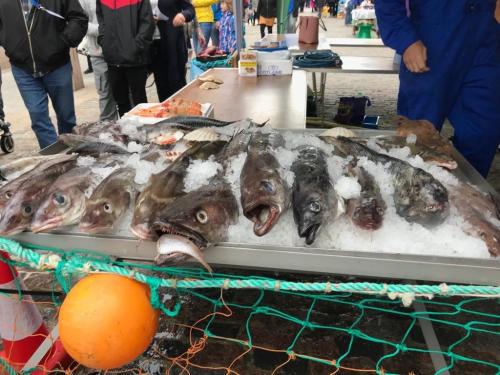
Transforming our diets to build a more sustainable food system is paramount to achieving net zero. Here, we provide a high-resolution perspective on United Kingdom (UK) seafood supplies and nutrient flows at species level. We mapped seafood production (capture and aquaculture), trade (imports and exports), purchases (within and out-of-home), and seafood consumption, between 2009 and 2020. UK dietary recommendations for finfish consumption were not achieved by domestic production nor national supplies. Mapping dietary nutrient flows revealed that the UK undergoes substantial losses of omega-3 fatty acids, vitamins B12 and D. Policies should consider promoting greater consumption of locally produced oily fish species to improve public health and seafood system resilience.
Stage
Work CompletedPurpose
Transforming diets to build a more sustainable food system is paramount to achieving net-zero by 2050. Proposals to reduce greenhouse gas emissions include adopting plant-rich diets, i.e., those rich in vegetables and oily fish, such as the Mediterranean or planetary health diet.
Not only do most seafoods have lower emissions than land-based protein foods, but they also provide more nutrients, than terrestrial alternatives, at lower emissions. Modelling for optimal UK diets found that oily fish was the most common item that could be added to our diets to make them healthier and more sustainable. Therefore, it is likely that seafood will feature more in our diets as we transition to net-zero and to ensure a sustainable increase in seafood consumption, we need to map seafood supply chains.
Our research aims to understand how seafood consumption in the UK relates to food supply chains - what is being produced, what is imported and exported, and how does this relate to what we eat and what we should be eating for optimal health.
Results
1. The UK is a net-importer of seafood, with most of the seafood produced being exported. The majority of seafood that we consume are fish dishes, including fish curries and fish pies.
2. UK seafood exports were dominated by oily fish, notably mackerel, herring, and salmon. Production values were greatest for oily fish, notably of the species we export the most. Prawns, cod, haddock, tuna and prawns made up the majority of imported fish; unsurprisingly, the most imported fish are included the “big 5” i.e., the most consumed species in the UK: cod, haddock, salmon, tuna, and prawns.
3. The UK experiences large losses in nutrients from seafood through international trade, notably omega-3 fatty acids and vitamin B12. Such nutrient losses are primarily happening through exports of oily fish- fish not commonly consumed in the UK. We calculated that if all mackerel, herring, and salmon were retained for domestic consumption, the dietary recommendation for oily fish intake would be satisfied.
Benefits
There is currently a mismatch between what seafood is being produced and consumed in the UK. Consequently, the UK experiences large nutrient losses from international seafood exports. Our research has highlighted the potential opportunities to reshape our seafood supply chains, by proposing increased consumption of locally caught species, such as herring and mackerel, that optimise nutrient intake, whilst minimising climate emissions.
Extensively mapping the UK supply chain will be of international significance because seafood is a global commodity. Understanding how national seafood consumption relates to food supply chains and global trade is essential to help develop both fisheries as well as public health policies that promote the consumption of locally produced species. Furthermore, developing innovative healthy seafood products may nudge consumers towards increasing and diversifying fish intake as we transition to net zero.
This new knowledge will help us to reconsider national food supply chains, but also ensure that current national dietary guidelines consider seafood supplies and the sustainability of production systems rather than solely focussing on consumer health outcomes, as is currently the case.
- Data Availability: The database created is publicly available on the UK Data Archive: https://doi.org/10.5255/UKDA-SN-856955.
- Code Availability: The code is publicly available on GitHub: https://github.com/The-Rowett-Institute/RI-B5-04_Seafood_Database.
Directory of Expertise
Project Partners
- Dr Bernard Scheliga, digital research specialist
- Peter van der Meulen (Marine Directorate/Scottish Government)
- Arina Motova-Surmava (Seafish, UK)